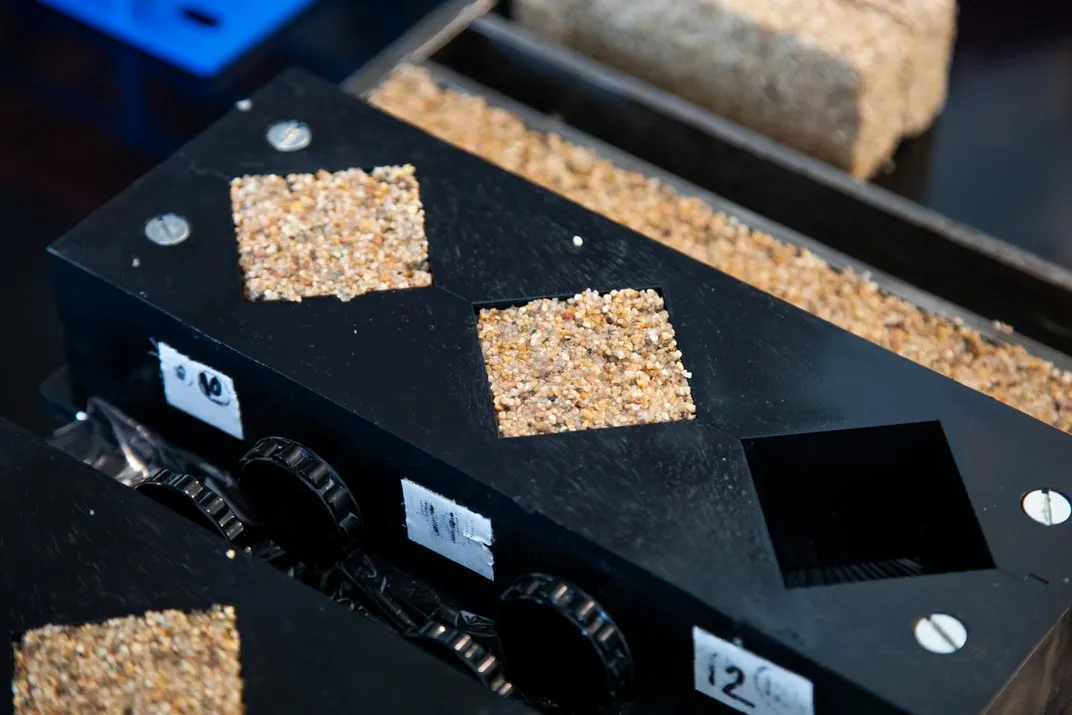Scientists Design Bacteria-Based Living Concrete
Its designers hope that it could help with construction in deserts or even on Mars
/https://tf-cmsv2-smithsonianmag-media.s3.amazonaws.com/filer/a3/06/a306d76d-5d22-4ade-bf92-eec2193c3c7f/bacteriaconcrete1.jpg)
A new kind of concrete developed at the University of Colorado, Boulder is teeming with life. Unlike traditional concrete, which is a mix of water, sand, and cement, this new material incorporates two new ingredients: photosynthetic bacteria and gelatin.
According to the study, published in the journal Matter, bricks of the so-called “living concrete” are made by mixing the ingredients in a mold. The researchers created arches, two-inch cubes, and shoebox-sized bricks, all of which start out green—a result of the bacteria’s photosynthetic abilities—before fading to brown as the material dries. The bacteria uses the gelatin and nutrients to hold the sand together in a web of minerals.
“It’s a lot like making rice crispy treats where you toughen the marshmallow by adding little bits of hard particles,” structural engineer and co-author Wil Srubar says in a university statement.
Although bricks of the living concrete are weaker than most modern concretes, the two-inch cubes could hold the weight of a person standing on top of them. The bricks also have the advantage of regeneration. When half of a brick is mixed with additional nutrients, sand, gelatin, and warm water, the bacteria in the original piece can grow into the added material. In seven days, the scientists had two bricks instead of one. They repeated the test several times to show that the bacterial bricks could be used for exponential brick reproduction, eventually creating eight bricks from the original.

The concrete “represents a new and exciting class of low-carbon, designer construction materials,” University of Strathclyde concrete expert Andrea Hamilton tells Amos Zeeberg at the New York Times.
For now, the living concrete has a few limitations. For example, generating new bricks requires some bacteria to still be alive in the first one. The bacteria the research team used, called Synechococcus, needs a humid environment in order to live. After 30 days in a humid environment, about nine to 14 percent of the bacteria left in the brick were still viable. That’s better than previous attempts to create bacterial concrete, but won’t help in the desert, where the research team hopes the concrete would be useful.
“Out in the desert, you don’t want to have to truck in lots of materials,” Srubar tells the New York Times. But as long as there are still living bacteria in one brick, it can bind a variety of materials together, he adds. “We’re not pigeonholed into using some particular kind of sand. We could use waste materials like ground glass or recycled concrete.”
The study was funded by Defense Advanced Research Projects Agency (DARPA), a branch of U.S. Department of Defense, whose preference for faster-solidifying concrete sparked the inclusion of supermarket gelatin in the mixture. Moving forward, the team hopes to create a version that’s more resistant to dehydration and doesn’t require added gelatin.
If the bricks prove useful in Earth’s arid climates, Srubar has his sights set further afield.
“We're not going to be trucking bags of cement all the way to Mars,” he says in a statement. “I really do think that we'll be bringing biology with us once we go."